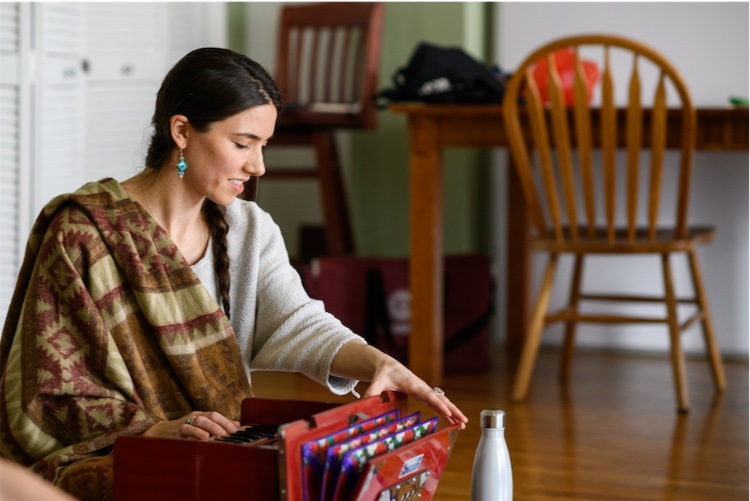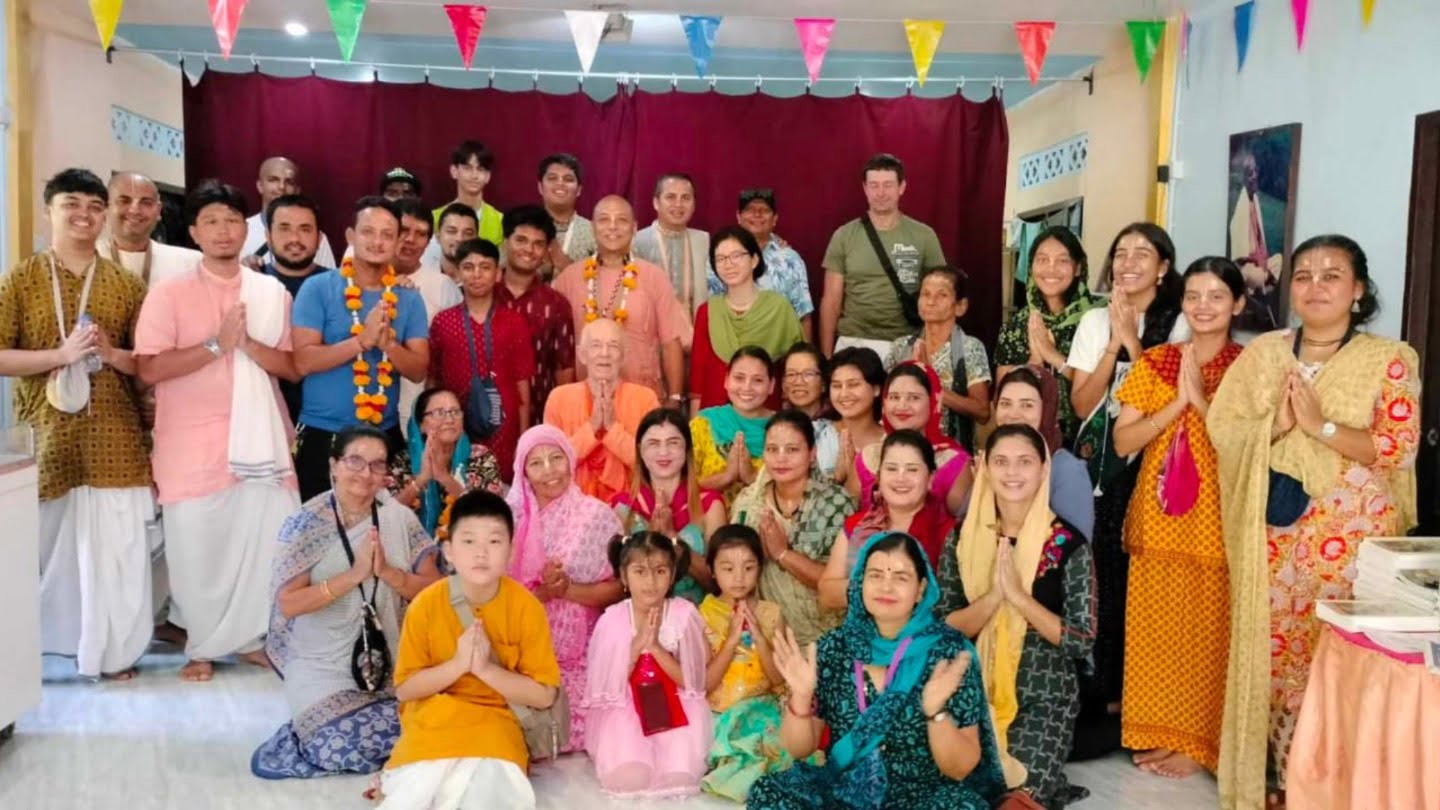Bhakti Center Launches New Kirtan School
By Madhava Smullen | Мар 30, 2019

The Bhakti Center in Manahattan has launched a Kirtan School, offering comprehensive step-by-step training in the devotional art.
The Center has always offered sporadic kirtan programs. But recently two things happened that set the course for a more “proactive, intentional and strategic approach,” according to Kirtan School director Doyal Gauranga Das.
First, devotees taught a three-hour “kirtan camp” in November 2017, which sold out immediately, revealing a strong public desire to learn kirtan.
Next, they offered a training in October 2018 that was specifically designed to show yoga teachers how to incorporate kirtan into their classes. This also met with major success.
This Spring, the Bhakti Center has brought these components together, tweaked them, and created the Kirtan School. Teachers include Jahnavi Harrison, who co-founded Kirtan London and has toured with Gaura Vani; Kishor Gopal, a mridanga player who has toured with Madhava; Kevin Tobar, a Bhakti Center manager; and Doyal Gauranga.

Doyal Gauranga Das (in dark green shirt) and Kevin Tobar (in kirtan shirt) with kirtan students
“We’ve planned out a trajectory, from ‘I’ve never played an instrument before in my life,’ to ‘I could go somewhere and lead kirtan, explain what it is and feel comfortable in that role,’” says Doyal.
The School has a broad audience. It’s for those who know nothing about Gaudiya Vaishnavism or the Hare Krishna Movement, and want to learn more about kirtan after hearing it on a Krishna Das album or in their yoga class. But it’s also for devotees who would like to become a better kirtan musician, understand kirtan more deeply, and learn how to explain it to people in a more effective way.
Beginners can take the two-hour Intro to Kirtan Workshop, offered monthly. There, they learn the basics, such as how to care for a harmonium, how to pump the bellows, what kirtan is – devotional singing, and the meaning of mantra. They also learn a simple Hare Krishna mantra melody and practice it together.
The Foundations of Kirtan course, held over a full weekend every other month, extends the training further. Students learn a variety of Hare Krishna mantra melodies and Vaishnava songs, including Radhe Govinda and Govinda Jaya Jaya.
But most importantly, they get to dive deep. They learn the history and philosophy of kirtan. They read from Sri Chaitanya Mahaprabhu’s Siksastakam, and discuss the effects of kirtan and the proper mood for chanting.

Samantha practices harmonium
“We also talk about kirtan lifestyle, and how living a life of spiritual integrity affects our ability to chant with effectiveness,” Doyal says. “Because kirtan is not just about the music – it’s about your devotion, where it’s coming from in your heart. And to feel the effects of kirtan we need to incorporate certain spiritual principles in our life.”
Finally, a 100-hour kirtan training, held over four weekends, is currently being offered by Gaura Vani and Jahnavi Harrison. Going forward, Kirtan School teachers plan to break this course up into intermediate and advanced levels, both two weekends long and set to launch this fall.
Musically, these levels will go beyond chords and into more advanced melodies, and teach other bhajans and songs. They’ll also delve even deeper into bhakti philosophy and how it relates to kirtan practice.
Mridanga, kirtan rhythm and kartal workshops are also offered. Each class is kept down to no more than ten people, so as to provide the best experience.
Looking to the future, the Bhakti Center Kirtan School also aims to create an Ambassador training program, which will teach students what it means to be an ambassador of Lord Chaitanya’s kirtan movement.

Students gather for a Foundations of Kirtan training
“Kirtan is very popular in the culture right now and is continuing to grow, but a lot of people aren’t clear on the history,” Doyal Gauranga says. “We also want to let people know that there are a lot of different ways to do kirtan, and explain to them how we specifically do kirtan as Gaudiya Vaishnavas, why we do it in that way, and what mantras and bhajans we chant.”
Programs outside of the classes, designed to create a vibrant kirtan community in New York City, are being planned too.
A kirtan outreach team, headed by teachers Jahnavi Harrison and Kevin Tobar, will take kirtan to other parts of the city. And six one-week-long kirtan practice groups of six to eight people each will be launched in the summer.
“One of our teachers will be assigned as the leader of each group,” Doyal says. “Each meeting will last an hour and a half. There will be a short discussion about kirtan to keep our enthusiasm and faith growing. Then everyone will get to lead a five or ten-minute kirtan. It will be a place where people can lead kirtan in a supportive environment, and keep their practice alive.”
For now, those interested can attend the Bhakti Center Kirtan School’s Intro to Kirtan workshop on April 20летний; and the Foundations of Kirtan on April 5летний– 7летний, or May 31st– June 2nd. A six-week mridanga course taught by Kishor Gopal will start on May 11летний. The Bhakti Center also holds kirtan programs on Tuesday and Thursday nights every week.
“With the Kirtan School, we want people to feel more connected to the practice of kirtan itself,” says Doyal Gauranga. “Often, there’s a barrier when it comes to kirtan. People feel like, ‘I’m the audience, I’m a spectator, I’d never be able to do it.’ We want to break down that barrier and help them feel like, ‘I can do this!’ whether it’s at a kirtan program or just at home. Kirtan is for everybody!”
He adds: “Ultimately, on the highest level, we want kirtan to spread. We want to equip people to learn not just how to play music, but also how to represent the kirtan movement in a way that they can go and share it in a meaningful way with others.”
* * *
Find details on upcoming kirtan courses here: http://bhakticenter.org/culture/
For more information, contact Doyal Gauranga directly at: doyal@bhakticenter.org














